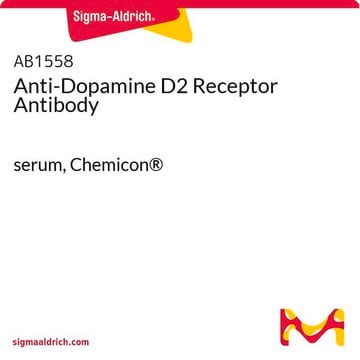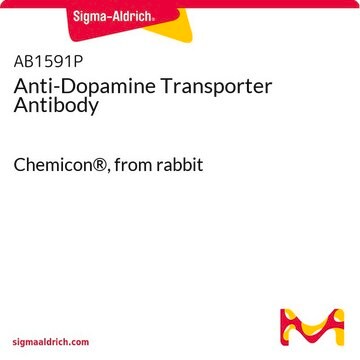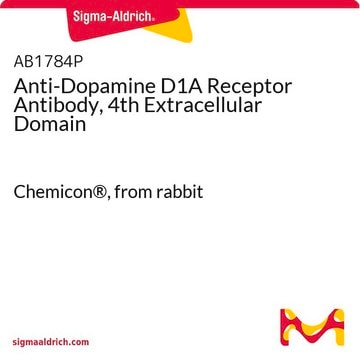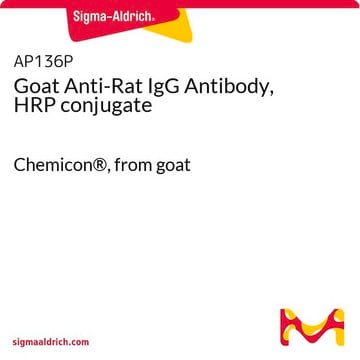MAB5292
Anti-Dopamine D1B Receptor Antibody, clone SG4-D1B
clone SG4-D1B, Chemicon®, from mouse
Sinónimos:
Dopamine D5 Receptor
About This Item
Productos recomendados
origen biológico
mouse
forma del anticuerpo
purified immunoglobulin
tipo de anticuerpo
primary antibodies
clon
SG4-D1B, monoclonal
reactividad de especies
mouse, rat
no debe reaccionar con
human
fabricante / nombre comercial
Chemicon®
técnicas
immunohistochemistry: suitable
western blot: suitable
isotipo
IgG1
Nº de acceso NCBI
Nº de acceso UniProt
Condiciones de envío
wet ice
modificación del objetivo postraduccional
unmodified
Información sobre el gen
human ... DRD5(1816)
Especificidad
Inmunógeno
Aplicación
Neuroscience
Neurotransmitters & Receptors
Immunohistochemistry
Optimal working dilutions must be determined by the end user.
SUGGESTED WESTERN BLOT PROTOCOL
Solutions
10X Transfer buffer 1 liter
Tris 115.3 gm
Glycine 24.2 gm
[SDS 4 gm (may be omitted)]
For a 1X working solution: 1 liter
mix 700 mL water
200 mL
MeOH100 mL
10X Transfer
TBSTstock 1 liter1M
Tris pH 7.5 10 mL
5 M NaCl 30 mL
10% Tween-20 5 Ml
1. Run SDS-PAGE gel as desired.
2. Soak PVDF membrane (ImmobilonP from Millipore) in 100% methanol for 1-2 minutes to wet the membrane.
3. Soak membrane in transfer buffer (see below) until ready to set up blot (>15 min) transfer.
4. Assemble gel-transfer sandwich with the blot toward the positive electrode.
5. Transfer protein from gel to membrane at 100 volts for 1-2 hours for small molecular weight proteins or 65 mA for 16 hours (overnight) for complete transfer of higher molecular weight proteins.
6. Stain the transferred bands with Chemicon BLOT-FastStain (Catalog Number 2076).
7. Destain with deionized water.
8. Block with 5% non-fat milk (Marvel or Carnation) in water, overnight at 4°C. The non-fat milk should be dissolved freshly, centrifuged 10,000 rpm for 10 min, and filtered through glass filter (Gelman Acrodisc).
9. Incubation with first antibody overnight with rocking at 4°C in blocking solution. Optimal working dilutions and incubation time will need to be determined by the end user.
10. Wash at least 3 x 5 min. with TBST. From this stage, azide should be omitted.
11. Incubation with the secondary antibody (HRP-conjugated goat anti-mouse antibody, for example Chemicon Catalog Number AP124P, diluted appropriately) 1 h at room temperature.
12. Wash at least 3 x 5 min. with TBST.
13. Perform ECL with commercial kit (femtoLUCENT, Chemicon Catalog Number 2078).
Ligadura / enlace
Forma física
Almacenamiento y estabilidad
Otras notas
Información legal
Cláusula de descargo de responsabilidad
¿No encuentra el producto adecuado?
Pruebe nuestro Herramienta de selección de productos.
Código de clase de almacenamiento
10 - Combustible liquids
Clase de riesgo para el agua (WGK)
WGK 2
Punto de inflamabilidad (°F)
Not applicable
Punto de inflamabilidad (°C)
Not applicable
Certificados de análisis (COA)
Busque Certificados de análisis (COA) introduciendo el número de lote del producto. Los números de lote se encuentran en la etiqueta del producto después de las palabras «Lot» o «Batch»
¿Ya tiene este producto?
Encuentre la documentación para los productos que ha comprado recientemente en la Biblioteca de documentos.
Nuestro equipo de científicos tiene experiencia en todas las áreas de investigación: Ciencias de la vida, Ciencia de los materiales, Síntesis química, Cromatografía, Analítica y muchas otras.
Póngase en contacto con el Servicio técnico








